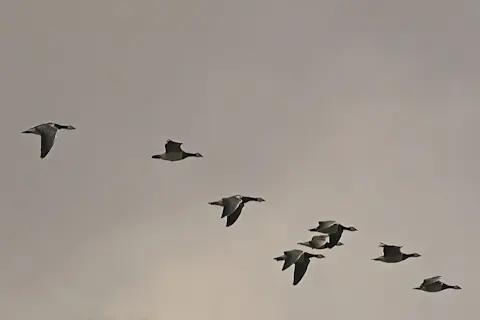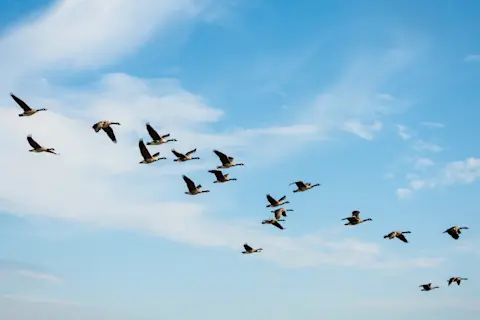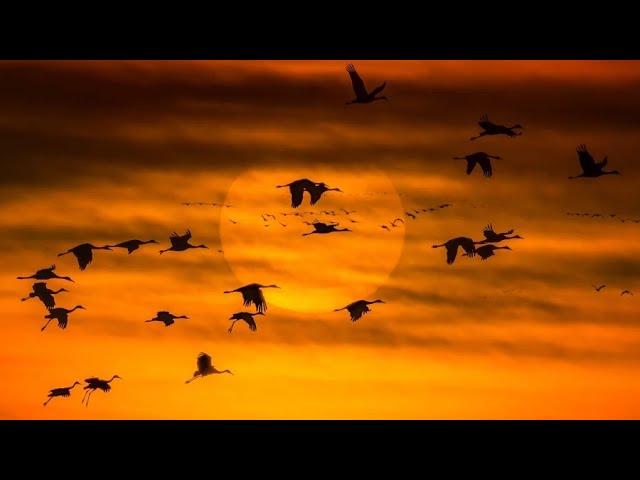Have you ever wondered if all birds fly south for the winter? You might be picturing flocks of birds gracefully heading towards warmer climates as the temperature drops.
But is this true for every bird species? The answer might surprise you. Understanding the unique behaviors of different birds can change how you view these fascinating creatures. You’re about to discover why some birds choose to stay put, while others embark on incredible journeys.
By the end of this article, you’ll not only have answers but also a newfound appreciation for the survival strategies of our feathered friends. Keep reading to uncover the mysteries of avian migration and find out if your assumptions about birds are true or just myths.

Credit: www.discovermagazine.com
Bird Migration Basics
Understanding bird migration basics helps you appreciate why some birds take long journeys while others stay put. Migration is more than just flying south for the winter; it’s a survival strategy shaped by nature’s demands. Let’s look at what drives birds to migrate and the common routes they follow.
Why Birds Migrate
Birds migrate primarily to find food and suitable breeding conditions. When winter approaches, food becomes scarce in many places, pushing birds to warmer areas. Your backyard might seem quiet, but thousands of birds are on the move to survive.
Some birds also migrate to avoid harsh weather and predators. Imagine how tough it would be to find insects or berries under snow. Migration gives birds a better chance to thrive.
Common Migration Patterns
Bird migration follows some well-known routes, often called flyways. These paths are like highways in the sky, used year after year by millions of birds.
- North-South Flyways:Many birds travel from northern breeding grounds to southern wintering areas. The American robin, for example, heads south to the southern U.S. or Mexico when food runs low.
- East-West Movements:Some species move laterally to find better conditions. Certain shorebirds shift along coastlines instead of directly south.
- Altitude Changes:Not all migration is horizontal. Some birds fly to higher or lower elevations to escape cold or find food.
Have you ever wondered how birds know these routes without maps? They use a combination of the sun, stars, Earth’s magnetic field, and even landmarks. This natural GPS is part of what makes migration so fascinating.

Credit: www.discovermagazine.com
Not All Birds Fly South
Not all birds take the long journey south when winter approaches. While many species migrate to warmer climates, a surprising number choose to stay in their original habitats year-round. Understanding which birds stay and why can change how you view the winter landscape around you.
Species That Stay Put
Some birds are tough enough to handle the cold. Chickadees, for example, often remain active and visible during winter. You might also spot cardinals, woodpeckers, and blue jays in your backyard, even on the coldest days.
These birds have adapted to survive harsh conditions. They rely on different strategies like fluffing up their feathers to trap heat or finding food sources that don’t disappear with the snow. Have you noticed how some bird feeders attract the same visitors all winter long?
Reasons Some Birds Don’t Migrate
Why do some birds skip migration? The answer often lies in food availability. Birds that eat seeds, nuts, or insects hidden under bark can find enough to eat even in winter.
Energy conservation is another factor. Migration requires a huge amount of energy, and if a bird can survive without flying thousands of miles, it usually will. Safety also plays a role—some birds avoid migration to escape predators or harsh weather along migratory routes.
Think about your own choices when facing challenges. Sometimes staying put and adapting works better than moving away. What lessons can you draw from these birds about resilience and adaptation?
Alternative Winter Strategies
Not all birds take the long journey south when winter approaches. Some choose different ways to survive the cold months without flying thousands of miles. These alternative winter strategies can teach you about adaptability and resilience in nature.
Hibernation And Torpor
While true hibernation is rare in birds, many species enter a state called torpor to save energy. During torpor, birds lower their body temperature and slow their metabolism for short periods, often overnight. This helps them survive cold snaps without needing extra food or warmth.
Take the chickadee, for example. It uses torpor to get through freezing nights, then wakes up active and ready to find food. Could you imagine conserving energy so efficiently just by resting differently?
Changing Habitats Locally
Some birds don’t migrate far but move to nearby areas that offer better shelter or food. They might shift from dense forests to urban areas where gardens and bird feeders provide warmth and sustenance. This local movement helps them avoid harsh conditions without traveling great distances.
Think about the way crows or blue jays adjust their usual spots depending on the season. You might notice them closer to your home during winter, showing how small habitat changes can make a big difference.
Surprising Migratory Destinations
Many birds do not follow the simple north-to-south path for migration. Some take surprising routes that challenge common ideas. These journeys show the variety and complexity of bird migration. Birds travel to unusual destinations to find food, safety, and better climates. Understanding these surprising migratory destinations helps us appreciate nature’s diversity.
Flying East Or West
Not all birds fly south for winter. Some fly east or west instead. For example, certain species head toward large bodies of water or islands. These places offer food and shelter during cold months.
Flying east or west can help birds avoid bad weather or strong winds. This choice also reduces competition for resources. It shows how birds adapt to their environment in smart ways.
Unusual Migration Routes
Some birds take very unusual routes during migration. They may travel longer distances or cross deserts and mountains. These routes seem risky but have benefits.
For instance, some shorebirds fly from Arctic breeding grounds to Australia. Others cross the Sahara Desert to reach tropical Africa. These routes help birds find areas with less predators and more food.
Unusual migration routes are a reminder that bird travel is full of surprises. It reveals how flexible and resourceful birds can be.
Human Impact On Migration
Human activities have a strong effect on bird migration. Changes in the environment caused by people change bird behavior. Many birds depend on safe and stable habitats to travel south in winter. Disturbances can confuse birds or block their routes. Understanding these impacts helps protect migrating birds.
Climate Change Effects
Climate change shifts weather patterns and temperatures. Birds may start migrating earlier or later than usual. Some species may stop migrating if winters become warmer. Food availability changes as plants and insects react to new climates. This forces birds to adapt quickly or face survival risks. Extreme weather events also threaten bird journeys.
Urbanization And Habitat Loss
Urban growth destroys natural bird habitats. Trees, wetlands, and fields turn into buildings and roads. Many birds lose resting and feeding spots on migration routes. Light pollution from cities confuses birds during night flights. Noise pollution disturbs their communication and navigation. Protecting green spaces and creating bird-friendly areas helps migration survival.

Credit: www.wildlifenomads.com
How To Observe Migration
Observing bird migration is an exciting way to connect with nature. You get to witness a spectacular journey that many birds take annually. With some knowledge and preparation, you can turn a simple walk into a fascinating birdwatching adventure.
Best Times And Places
Timing is crucial for spotting migrating birds. Early mornings and late afternoons are often the best times to see birds actively moving. Look for clear days with favorable winds, as these conditions encourage migration.
Locations near water bodies, open fields, and forest edges are perfect spots. Coastal areas and mountain passes often act as natural funnels for migrating birds, increasing your chances of sightings. Have you noticed that some parks feel livelier during certain months? That’s migration in action.
Tools And Resources For Birdwatchers
Having the right tools enhances your birdwatching experience. A good pair of binoculars brings distant birds closer, revealing details you’d otherwise miss. Carry a field guide or use a bird identification app to help recognize different species.
Joining local birdwatching groups or online communities can provide valuable tips and migration updates. Websites like eBird offer real-time migration maps submitted by fellow birders. These resources turn your observations into part of a larger conservation effort.
Frequently Asked Questions
Do All Bird Species Migrate South For Winter?
Not all birds migrate south for winter. Some species stay in their habitats year-round. Migration depends on food availability and climate conditions.
Why Do Some Birds Not Fly South In Winter?
Some birds adapt by growing thicker feathers or changing diets. They find food locally and survive colder temperatures without migrating.
How Do Birds Know When To Migrate South?
Birds use environmental cues like daylight length and temperature changes. These signals trigger hormonal changes that prompt migration behavior.
What Happens To Birds That Don’t Migrate South?
Non-migratory birds often face harsher winters. They use strategies like hibernation, food caching, or seeking shelter to survive the cold.
Conclusion
Not all birds fly south for the winter. Some stay where they live. They find food and shelter nearby. Others move only a short distance. Each bird has its own way to survive cold months. Understanding these habits helps us appreciate nature more.
Next time you see a bird, think about its journey. Nature is full of surprises.

